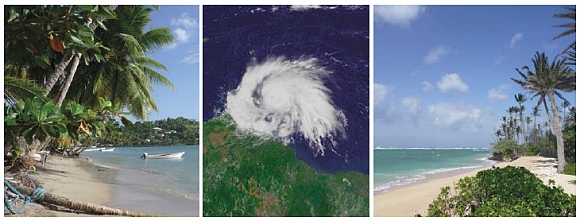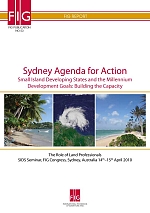FIG PUBLICATION NO. 53
Sydney Agenda for Action
Small Island Developing States and the Millennium Development
Goals: Building the Capacity
The Role of Land Professionals
SIDS Seminar, FIG Congress, Sydney, Australia 14th–15th April 2010
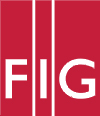
Contents
1. Foreword
2. Executive Summary
Global Challenges
The FIG Agenda
The Seminar
Role of Land Professionals
An Agenda for Action
Conclusions
3. Agenda for Action
4. Seminar Profile
Seminar Background
Seminar Profile
Role of Government
Role of Land Professionals
5. Building the Capacity
Capacity Assessment and Development
Capacity in SIDS
Building the Capacity in the Pacific Region
6. Appendices
Seminar Programme
Summary of Presentations
Participants List
Recommended References
Orders for printed copies
1. Foreword
This publication is a result of the seminar on “Small Island Developing
States and the Millennium Development Goals” held 14–15 April during the FIG
International Congress in Sydney, Australia 11–16 April 2010. It includes a
report of the seminar and an Agenda for Action as the main outcome of the
seminar.
The seminar was organised to address the challenges that the Small Island
Developing States (SIDS) are facing in achieving the Millennium Development
Goals (MDGs) and with a special focus on the Pacific Region. In keeping with the
Congress theme “Facing the Challenges – Building the Capacity”, the workshop
articulated the input of land professionals in the Pacific Region and defined
how mechanisms and capacity requirements can be met and can contribute to
achieving the MDGs.
The seminar emphasised the importance of good land governance especially in
relation to climate change and natural disaster; access to land, coastal and
marine resources; and secure land tenure and administration. The seminar adopted
the “Sydney Agenda for Action” that aims at building the capacity of land
professionals to deal with these challenges.
The organisers wish to thank all who participated, contributed, supported and
encouraged this seminar. Especially it is gratefully acknowledged the funding
providing by Aus Aid, FAO, Commonwealth Foundation, and NZ Aid to support
participation of representatives from the Pacific Region small island developing
states, and from other regions throughout the world.
The seminar was organised by Dr. Diane Dumashie, Chair of FIG Commission 8,
Director of Dumashie Ltd, UK with a lead team consisting of Dr. Mele Rakai,
President of PILPA and CASLE Pacific, University of South Pacific, Fiji, Mr.
Tony Burns, Managing Director and Kate Dalrymple, Land Equity International Pty
Ltd, Wolongong, Australia; Dr. David Mitchell, Royal Melbourne Institute of
Technology, Australia, and Mr. Bill Robertson, Director of Bill Robertson
Associates, New Zealand. FIG would like to thank the members of the lead team
for all their great efforts in organising this seminar and also drafting the
“Sydney Agenda for Action” for consideration and adoption by the seminar.
Finally, we wish to convey our sincere gratitude and thanks to all the
delegates who travelled from all parts of the world to attend this conference
and whose active and enthusiastic participation ensured the success of this
seminar.
The Sydney Agenda for Action will hopefully serve as a guiding document for
the land professionals in SIDS, specifically in the Pacific Region in building
the capacity to meet the challenges of the future. FIG is committed to support
this process.
Stig Enemark
FIG President
|
Diane Dumashie
Seminar Organiser
Chair, FIG Commission 8 |
2. Executive Summary
The challenges of the new millennium are well rehearsed and clearly stated.
The eight Millennium Development Goals (MDGs) form a blueprint agreed by all
world’s countries and the world’s leading institutions. The first seven goals
are mutually reinforcing and directed at reducing poverty in all it forms. The
last goal – global partnership for development – is about the means to achieve
the first seven. The MDGs represent a wider concept or a vision for the future,
where proper land governance is central and vital and where the contribution of
land professionals is fundamental.
The world is also facing global issues of rapid urbanisation, climate change,
natural disasters and environmental degradation. These issues all relate to
governance and management of land. Measures for dealing with these global issues
must be integrated into strategies for poverty reduction to ensure sustainable
development and to meet the MDGs. Consequently, the land governance perspective
and the role of the land professionals need high-level political support and
recognition.
FIG adopted the theme “Building the Capacity” for the current term of office
2007–2010. This relates to land professionals “flying high” by facing the global
agenda in terms of contributing to meeting the Millennium Development Goals. It
also relates to land professionals “keeping the feet on the ground” by
contributing to building the necessary capacity for dealing with professional,
organisational and technology development at national and local levels. These
aims are also reflected in the theme of the FIG Congress in Sydney in April
2010: “Facing the Challenges – Building the Capacity”.
Specifically, the seminar on Small Island Developing States aims to
contribute to building the capacity for land professionals and their national
organisations and institutions to face the challenges of meeting the MDGs. FIG
is committed to support this process of resilience and sustainable development,
especially through partnerships with the UN agencies and strategic alliances
with the Pacific Islands Land Professionals Association (PILPA) and other
organisations such as CASLE, SSSI and NZIS. This will require a strong and deep
commitment to establishing a healthy land professionals´ network in the region.
The seminar involved about 50 representatives from small island states mainly
from the Pacific Region. In addition about 50 expert and other land
professionals contributed actively to the discussions. The important roles of
land governance in implementing the MDGs and contributing to building the
capacity of the land professionals in the region to deal with these challenges
were key themes. The seminar was divided into five sessions:
1. Building Professional Capacity
- Setting the scene for professional capacity building by identifying the
specific gaps in capacity in the region.
- Discussing ways in which land practitioners could contribute towards
closing the gaps and thus assist with the achievement of the MDGs.
2. Climate change and natural disasters
- Developing the relationship between climate change, community resilience
and land tenure.
- Discussing the input and contribution of land professionals in the
preparedness, mitigation, emergency response, recovery and rehabilitation
stages of Disaster Risk Management.
3. Access to land, coastal and marine resources
- Discussing the lack of clearly defined real property rights as a major
cause of dispute and resultant instability for SIDS.
- Exploring institutional impediments to land and resource access in SIDS
and investigating issues of gender and intergenerational equity
4. Good governance in land tenure and administration
- Exploring the topic of land governance as it applies to small island
states with a prevalence of customary tenure.
- Discussing the land sector as particularly susceptible to corruption and
rent seeking.
5. Building professional capacity
- Developing strategies and activities for building the professional
capacity of land professionals in the region.
- Identifying the roles that land professionals can play towards achieving
the MDGs in the region.
The selected themes identified the relationships between climate change,
community resilience, land tenure and the pathway to sustainable development of
land and natural resources, ensuring an equitable approach to economic
development to avoid land and resource conflicts.
The themes are described in more detail in section 4 below. The seminar
programme is available in the appendix in section 6. All presentations at the
seminar are available at the FIG website:
http://www.fig.net/pub/fig2010/techprog.htm.
Role of Land Professionals
Land professionals and practitioners have strong roles to play in developing
land policies, improving land tenure security, managing sustainable use of land,
and resolving conflicts over land and mapping vulnerability. To achieve this
they will need to fully understand land issues at the community level and be
able to communicate these at the political and decision-making levels. Land
professional should adopt the role of change agents and rise to its challenges.
Land is the root of change and land professionals need to direct change towards
economic, social, and environmental sustainability and good governance.
Dialogue is not delivery. Therefore, the seminar aimed to produced an agenda
for action on building the capacity of land professionals in the region. This
includes some general guidance and professional ethics; guidelines on developing
vehicles for building land professional capacity; guidelines on building roles
and responsibilities for land professionals; and institutional responsibility
for driving an agenda for SIDS specifically in the Pacific Region. The Agenda
for Action is outlined in section 3 below. Although the Agenda for Action is
developed for the Pacific Region it has direct relevant for SIDS across the
globe.
Effective and democratised land governance is at the heart of delivering the
global vision of our future laid out in the MDGs. The implementation of the MDGs
is however jeopardised by new challenges, especially climate change, natural
disasters and environmental degradation. Small island developing states, such as
in the Pacific Region, face challenges posed by size and geography that limit
possibilities for economic diversification and leave them highly vulnerable to
environmental risks.
Land professionals in these islands have vital roles to play and to promote
engagement from all sectors of society. A strong and deep commitment to
establishing a healthy land professionals´ network with sufficient capacity to
face the challenges and manage the people to land relationship is required.
The seminar has contributed directly and actively to this process by moving
the agenda forward for land professionals in SIDS.

Taurama Valley, Papua New Guinea © Max Kepp
3. Agenda for Action
Sydney Agenda for Action
Building Capacity in Small Island Developing States
The meeting resolves that land professionals in Small Island
Developing States (SIDS) build their capacity to address the agenda
stated in MDG 8, Target 14 in line with the principles set out in the
Paris Declaration and the Accra Agenda for Action, and optimizing social
and economic development by:
1 Flying high with feet on the ground
1.1 Becoming informed, multi skilled, ethical, practitioners and
professionals and change agents
1.2 Engaging, understanding and learning from communities to be more
effective as change agents
1.3 Increasing dialogue and forums for interaction with senior policy
makers in governments to develop political will for responsible land
management and informed reaction to needs and situations
1.4 Establishing strategic alliances and promoting the practice by
sitting on boards, accessing decision makers and developing
relationships with stakeholders
1.5 Identifying appropriate technology for given situations to achieve
appropriate and functional solutions
1.6 Ensuring a gender equal approach in the design of land policy and
the activities to implement these policies
1.7 Insisting that implementing agencies with assistance of consultants
build sustainable systems that require minimal continuing external
support and monitoring to ensure this happens
2 Developing vehicles for building land professional capacity
For education and training:
2.1 Gathering government funding and donor support for institutional
activities and ensuring that this support is best applied
2.2 Inventing new ways of training, including training the trainers,
remote education systems, new tools and off-campus learning arrangements
or open universities that facilitate two-way interaction and build the
capacity of local SIDS institutions
2.3 Developing alumni capacity for knowledge transfer among peers and
into the student groups
2.4 Working towards a multi-skilled approach in university programs
2.5 Building continuous professional improvement and training programs
2.6 Encouraging the engagement of interdisciplinary experts in training,
change management training, and risk management
2.7 Encouraging young people and women into the education institutions
2.8 Encouraging and supporting early education awareness and interest in
areas relevant to the land sector
For land professionals:
2.9 Developing social responsibilities and ethical standards through
active membership of professional organisations
2.10 Encouraging mentoring and being proactive in attracting new
entrants, both male and female, into the professions and retaining them
2.11 Developing work experience training e.g. attachment programs, and
on the job training, deployment and mentoring of graduates on land
projects, within and external to the region work experience
For professional organisations:
2.12 Using Web based communication systems and support mechanisms
for knowledge transfer and training
2.13 Improving the capacity of land practitioners to understand the risk
and manage the relationships with regard to:
– Person to person relationship management
– People to land relationships
– Customary and state land in situations of development transition
– Climate change
– Vulnerability to natural disasters and community resilience
2.14 Aligning professional programs with other important initiatives
(for example, developing informed responses to the Pacific Urban Agenda
and regional action plans, and other strategic initiatives)
2.15 Instituting education and professional processes that ensure public
trust, transparent processes and regulation of professional activities
2.16 Encouraging a broader perspective of land practitioners to develop
diverse skill levels appropriate for small nation states with limited
resources
For regional networks and organisations:
2.17 Building sustainable regional organisations, such as PILPA,
PIPA, so that that the region shares knowledge and experience to build
optimal capacity
2.18 Gaining recognition for PILPA as the legitimate organization
representing land practitioners
2.19 Producing regional guidance notes and information papers on
technical issues for member associations
2.20 Building long-term, sustainable relationships between:
– Practitioners and politicians
– Member organisations such as SSSI, NZIS and other local land
practitioners
– Global organisations such as CASLE and FIG
– Funding agencies
– All SIDS regions
to ensure they identify and prioritise the capacity needs of individual
countries
3 Building roles and responsibilities for land professionals
Achieving knowledge transfer from land practitioners to others by:
3.1 Ensuring consultants leave a legacy such as trained locals
3.2 Building appreciation and recognition of non-professionals for basic
land tools including survey infrastructure and mapping
3.3 Increasing dialogue and forums for interaction with senior policy
makers in governments to develop political will for responsible land
management and informed reaction to needs and situations
3.4 Sharing information and experiences on recent responses to natural
disasters and climate change that facilitate the management of and
resources
Identifying the capacities of land practitioners in Island States
that are needed NOW, including:
3.5 Multi-disciplinary professional capacities
3.6 Capacity to develop land policy frameworks
3.7 Capacity to identify the best practices for delivering security of
tenure in island states
3.8 Capacity to analyse and research attitudes to land
3.9 Capacity to manage pressures on land use, and understanding of
future roles of land
3.10 Capacity to communicate with stakeholders (clients, public and
government policy makers, NGOs) in changes to land relationships and
land uses
3.11 Capacity to map vulnerabilities and resilience of island states
4 Acting responsibly
Maintain and improve the livelihoods of people and environmental
sustainability by:
4.1 Maintaining highest professional standards
4.2 Eradicating corruption
4.3 Facilitating the agenda of social and economic development
5 Driving the agenda for the Pacific
In particular, in the region this is an agenda to build action
plans and it is expected that the following organizations will take this
forward:
5.1 PILPA (Pacific Islands Land Professionals Association) – to take
ownership of this Agenda for Action and provide the momentum and the
platform for developing action plans at the national and regional levels
5.2 Country – develop national action plans that feed into the regional
action plan
5.3 Development Partners – work to build relationships with national
governments, development partners, and policy makers to assist in
funding the resources to needed to implement the action plans
5.4 Strategic Alliances – work to build partnerships forums to progress
PILPA action plans with FIG, CASLE, and regional organizations SSSI,
NZIS. |
4. Seminar Profile
The Pacific Region represented in this seminar consists of many small
countries. Nevertheless the total population in the region is 10 million which
means that lots of people are affected by inadequate land administration systems
across the region, Because of the small size of most individual Pacific Island
States and the widely spread and isolated nature of the geography, the
challenges for land administration in the Pacific are much more extreme than for
larger developing states. Therefore there is a need for small scale urgent and
effective resolution of a range of common land administration problems.
Fully integrated sustainable development is a particularly important concern
for small island developing states, which are among the most vulnerable
countries in the world. Ocean and coastal zones form the basis for well-being
and development in SIDS, so the health of these environments is critical.
Limited land mass in SIDS creates sharply competing demands and development
pressures on natural ecosystems driven by economic activities and needs for
shelter, water and fuel. Coastal areas tend to be densely populated and may be
low-lying, making SIDS especially vulnerable to rising sea levels, climate
change and climate variability. Relationships between different sectors of the
economy are very close so that poor land management affects everybody.
Because of their size, SIDS are unable to capture economies of scale in their
domestic markets, or in their political, managerial and technical capacities.
These are characterised by open economies in which international trade is more
significant than it is in larger states. They tend to rely on a limited number
of external markets and a narrower range of commodities. Remoteness implies
higher costs for energy, transportation and communications, while extreme
weather events can sometimes destroy a country’s gross domestic product
overnight.

The Pacific Islands Region covers a very wide expanse of the world’s surface.
Today’s is the first generation with the resources and technology to tackle
poverty on a global scale and to free the entire human race from want. The MDGs
are a powerful concept towards development, security and human rights for all.
Surveyors and land professionals play a key role in this regard in terms of
providing some of the fundamental preconditions for development. These
preconditions are also embedded in the Millennium Declaration and spelled out in
the targets and indicators for achieving the MDGs.
In April 1994 a global conference was held in Barbados to consider how small
island States could face up to their special challenges. “The Global Conference
on the Sustainable Development of Small Island Developing States” determined
that sustainable development was the logical answer, and adopted the “Barbados
Programme of Action for the Sustainable Development of Small Island Developing
States” to help bring it about.
The MDGs mention SIDS direction in Goal 8 target 14 stating that the special
needs of small island developing states should be addressed. This will be
continuously measured as described in MDG indicator 35 that focuses on the
proportion of Official Development Assistance (ODA) for the environment in SIDS.
The MDGs are globally accepted benchmarks of broader progress, embraced by
donors, developing countries, civil society and major development institutions
alike. There is a shared vision of development. These goals can be met by 2015 –
but only if all involved break with business as usual, eradicate corruption, and
dramatically accelerate and scale-up action now (stated by UN 2005).
In January 2005, a high-level UN meeting was convened in Mauritius to review
the implementation of and refine the 1994 Barbados Programme of Action (BPoA)
for the Sustainable Development of SIDS. The principal negotiated outputs of the
meeting are a strategy document and a political declaration. The Mauritius
Strategy builds on and reassesses the original BPoA areas. It also highlights
several new priorities and emerging issues now considered important dimensions
of sustainable development in SIDS. The twenty chapters of the Mauritius
Strategy call for action in many fields related to UNESCO’s concerns, programmes
and priorities including climate change (1), natural disasters (2), coastal and
marine resources (4), and land resources (6).
Ultimately, the message is that the MDGs address some of the most fundamental
issues of our time. Many SIDS face challenges in terms of multiple impacts of
climate change, energy and waste; unprecedented growth in urbanisation; and
shortage of financial and technological resources or support. The scale and
speed of these changes are already undermining progress towards the MDGs.
Therefore, SIDS demand special attention due to their vulnerability, and
community action is particularly needed to achieve a resilient policy and
capacity approach.
The Pacific Islands Forum Secretariat (PIFS) cautioned in their 2008 Forum
Communiqué, that the Pacific Region has fallen behind in achieving the
Millennium Development Goals (MDGs) and is not on track to achieve them by 2015.
This was supported by the Lowy Report to the PIFS in August 2009, which
concluded that the Pacific region needs better targeted aid, investment in
infrastructure in rural areas, and more efforts to support and enable the
private sector.
The seminar was built around three global themes: Climate Change and Natural
Disasters; Access to Land and Resources; and Good Land Governance; with an
important and underlying theme of Building the Capacity. The selected themes
identified the relationships between climate change, community resilience and
land tenure and the pathway to sustainable development of land and natural
resources, to ensure an equitable approach to economic development and avoid
land and resource conflicts. Thus the themes in total reflect the Mauritius
strategy as well as the MDGs.
The Climate Change and Natural Disasters theme was designed to
articulate the input and contribution of land professionals in the preparedness,
mitigation, emergency response, recovery and rehabilitation stages of Disaster
Risk Management (DRM). This contribution encompasses surveying, land
administration, valuation, land use planning, and spatial information
management. Land issues need to be considered in each stage of the DRM process.
There is evidence of an increase in the frequency of natural disasters in the
last few decades. According to the Fourth Assessment Report of the International
Panel on Climate Change (IPCC 2007) climate change is very likely to lead to
increased frequencies and intensities of some extreme weather events such as
heat waves, tropical cyclones, floods and drought. SIDS are particularly
vulnerable to natural disasters, and the impacts of climate change. The tsunami
that hit Samoa and other Pacific Island Countries in September 2009 provided
graphic evidence of the vulnerability of coastal communities to the increasing
frequency and severity of natural disasters. SIDS also have less capacity to
respond to natural disasters, rebuild, and undertake adaptation and mitigation
measures to reduce vulnerability to future hazards. The most vulnerable are more
likely to live on disaster-prone land, and are at greatest risk of displacement
and loss of livelihood assets in the event of a disaster. The Pacific Island
countries have a high percentage of customary tenure and this presents unique
challenges for DRM.
Rapid urbanisation, combined with the effects of climate change, is placing
unprecedented pressure on land in SIDS. This is mostly experienced in vulnerable
coastal communities, and urban and peri-urban informal settlements. Many of
these are governed by customary tenure and are outside the formal land tenure
systems. Tenure security is related to poor capacity for resilience – the
majority of the people most vulnerable to natural disasters do not have formal
title to land. In many cases they have only informal tenure rights and are
vulnerable to eviction after a disaster. Informal settlements are often located
in coastal areas vulnerable to cyclones or storms, on steep slopes vulnerable to
landslides, or along flood plains.
Natural disasters are best understood not merely as the outcome of climatic,
biological, or geological hazards, but as a coupling of natural hazards with
human vulnerability. Disasters remove the means of generating an income (or
livelihood) and destroy any savings and assets.
The Access to Land, Coastal and Marine Resources theme aimed to
address the issue of access to these resources in SIDS to ensure appropriate
social and economic development of resources in the immediate future. The theme
also explored institutional impediments to land and resource access in SIDS
including the issues of gender and intergenerational equity, and the application
of land trusts, with a view to proposing workable leasehold solutions that avoid
creation of long-term perpetual lease structures. The objective was to identify
the lines of enquiry and the action steps that should form a local and
international agenda for land professionals to greatly improve access to
resources by the citizens of SIDS.
Common issues identified are unplanned rapid urbanization, inadequate land
administration systems for customary and other land, inadequate lease terms and
conditions of customary land, un-surveyed lands, difficulty in searching land
titles because of manual land registration systems, delays in registration or
customary land declarations, lack of direct public access for all land
information currently stored manually, and so on. The urgency for SIDS to
develop new and improved systems and methods is even greater than those in other
developing countries as SIDS are the more vulnerable and face more extreme
challenges.
The ready and efficient access to land and maritime resources for the
sustainable and equitable use of citizens of SIDS is crucial. Pressures on
access to resources arise through increasing demands of urbanisation,
sustainable food and water supply and environmental degradation. The range of
pressing issues bearing on the sustainable resource use of SIDS and their
resolution will require cooperative efforts and programmes at national, regional
and international levels.
Access to land and marine resources is challenged by a lack of clearly
defined real property rights, which in turn causes disputes and resultant
instability for SIDS. This situation is compounded when viewed from outside by
those who are familiar with the Western approach to land use and ownership. In
the South Pacific, for example, some 83–97% of land remains vested in the
stewardship of the indigenous guardians who retain the superior interest in and
control of the land.
It is generally accepted that this ‘superior’ interest in land – which
identifies who can determine its primary uses – should not be alienated, but
rather retained for the sake of intergenerational equity. To address the
differences between Western and indigenous views on land ownership and control,
Pacific Island governments should strive for land reform that encourages
leasehold solutions that are sensitive to customary ownership. These must strike
a balance between communal and individualised property rights that is agreeable
to their citizens. Moreover, institutional changes from lenders and financiers
are needed to accept Pacific models of access to land and resources as workable
tenures.
Land professionals have strong roles to play in developing land policy,
improving land tenure security, resolving conflicts over land and mapping
vulnerability. To achieve this they will need to fully understand land issues at
the community level and be able to communicate these issues at the political and
decision-making levels. Land professionals have the capability, the
international linkages and the opportunity to both lead and contribute to the
sustainable use of resources in their countries.
The Good Governance in Land Tenure and Administration theme was
focused on land governance as it applies to small island states with a
prevalence of customary tenure and a land sector being particularly susceptible
to corruption and rent seeking.
The small island states in the Pacific, typically grouped into three regions:
Melanesia, Micronesia and Polynesia cover a very wide expanse of the world’s
surface. Only small percentages of the region’s land resources have been
alienated to the state and most land operates under a range of customary land
tenure and land use systems. Despite their formal recognition the customary
tenure systems face increasing pressures from actors and institutions both
internal and external to the customary groups. The prevalence and importance of
customary tenure in the Pacific adds a level of complexity to any consideration
of land governance.
Over time the strong links between rights and responsibilities have eroded
and patterns of beliefs, values and behaviours have become less integrated and
more diverse. The expectation for continuing or on-going rights by individuals
and families that have migrated has added complexity in many countries. Women
and the younger generation are disadvantaged in access to land in some
countries. Land tenure problems have been a source of conflict and are
identified as a key obstacle to development in the region.
The land sector is particularly susceptible to corruption and rent seeking.
Land is an enormously valuable asset, typically accounting for 30–50% of
national wealth in developing countries. The value of land thus creates a
significant opportunity for corruption on the part of those with the legal
authority to assign, revoke, or restrict rights to it.
Land scarcity and demand in both urban and rural areas also increase the
pressure on good governance of land administration and management systems.
Population growth and urbanization drive up land value which affects housing and
property and makes implementation of planning and zoning regulations more
difficult. Rural areas experience increasing demands for escalating land values
of new land uses, such as bio-fuel agriculture or forest reserves for carbon
offsetting.
Development practitioners of all persuasions recognize the importance of
governance and the rule of law as essential preconditions for economic and
social development. Given the complexity of land issues virtually everywhere and
the fact that institutional arrangements are highly country specific systematic
guidance is needed to diagnose and benchmark land governance and to contribute
to improving the situation over time.
Significant challenges face Pacific Island governments as they look to
optimise economic development of the wider community whilst maintaining
safeguards and traditions of customary tenure that are embedded in the social
fabric of nations. Significant capacity building is required in order for land
professionals to adequately fulfil their important mandates. A third key
challenge for professionals is to earn the trust of both policy makers and the
community.
The underlying Building Professional Capacity theme with two sessions
and a wrap up discussion was devoted to building professional capacity to enable
the professionals to move forward. A key focus is on the interaction between the
public, private and educational sectors (such as government, professional
organisations and educational institutions) addressing what possible
partnerships can be created to face the challenges of the future.
Small Island developing states have unique problems such as the
interrelations between land and marine environments and customary tenure
highlighted by the chosen global themes, but their key issues are people, the
relationship between them, and the institutions governing their activities, so
ultimately the professional’s role is within the societal framework.

SIDS Seminar at FIG Congress, Sydney, Australia, 14th–15th April 2010.
© Stig Enemark
In order to build resilience, small island states should:
- take steps to promote good governance by pursuing appropriate policies
to ensure political stability and the enforcement of the rule of law, to
address corruption, as well as to promote accountability, transparency and
efficiency in the delivery of public services;
- promote social cohesion, support poverty eradication and sustainable
livelihoods and foster harmonious social development;
- protect and sustainably manage the environment, notably by taking steps
to increase energy efficiency, promote waste management, improve freshwater
resources management, and encourage sustainable use of biodiversity and
natural resources.
Relevant UN agencies, including the UN Conference on Trade and Development
(UNCTAD), the UN Development Programme (UNDP) and the UN Environment Programme
(UNEP), should continue to provide support to small states, particularly SIDS,
towards the promotion of sustainable development in general and resilience
building in particular.
Land professionals and practitioners have strong roles to play in developing
land policy, improving land tenure security, resolving conflicts over land and
mapping vulnerability. To achieve this they will need to fully understand land
issues at the community level and be able to communicate these at the political
and decision-making levels. More specifically the roles of land professionals
are to:
- Understand the underlying land tenure and land use arrangements. Capture
and record the nature of the relationships that different peoples have with
their customary lands regarding their sense of identity, their ancestral
obligations and rights of stewardship and the key relationships between
groups of people.
- Map vulnerability and resilience to assist with preparedness and
mitigation, and manage situations after a disaster strikes. Assign values to
the level of vulnerability or resilience to allow for decisions on priority
areas for mitigation and adaptation measures.
- Provide innovative options for improving tenure security incrementally
along a ladder of rights for those with the most insecure tenure.
- Provide information on factors contributing to vulnerability such as the
distribution of land, land tenure status, existing livelihoods, and the
location of infrastructure.
- Communicate information effectively relating to the tenure security of
customary lands to assist customary landowners to make informed decisions.
- Develop land policies based on inclusive and consultative processes that
make provisions for those at highest risk of a natural disaster, and those
with poor tenure security.
- Analyze land governance at all levels and implement measures to improve
governance in the land sector.
- Contribute to the development of effective land dispute resolution
mechanisms for both customary and formal land tenures.
(Grenville Barnes presentation in session 2.)
Land professional should adopt the role of change agents and rise to its
challenges. Land is the root of change and land professionals need to provide
the leadership that delivers economic, social, and environmental sustainability
and good governance.
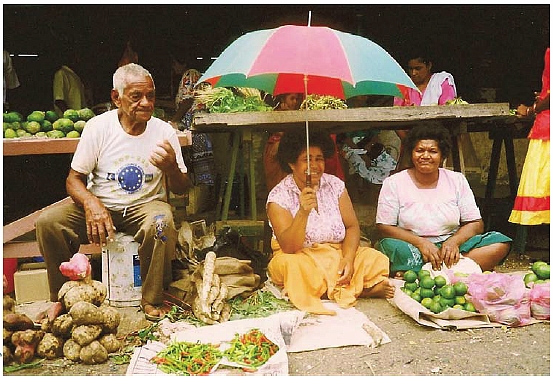
Fiji © Stig Enemark
5. Building the Capacity
Capacity Assessment and Development
Developing countries – such a SIDS – need to ensure that their land is
effectively and appropriately managed; that management can support economic
growth of the country; and that people´s interests are adequately protected.
This requires governments to establish effectively operating land administration
systems.
Building the capacity is the key issue in building or reforming land
administration systems. Capacity building measures must be seen in a wider
context of developing and maintaining institutional infrastructures in a
sustainable way. Only then can a capacity building concept guide assessment of
capacity needs and identify adequate responses at societal, organisational and
individual levels.
UNDP offers this basic definition: “Capacity can be defined as the ability of
individuals and organizations or organizational units to perform functions
effectively, efficiently and sustainable.” Capacity is seen as two dimensional:
1. Capacity assessment that is a structured and analytical process
whereby the various dimensions of capacity are assessed and the capacity needs
identified in relation to undertaking the relevant tasks within the system.
2. Capacity development is about developing the capacity and skills
for meeting the capacity needs of performing the core functions. The measures of
capacity development may be in terms of education and training or it may be in
relation to institutional and organisational restructuring.
UNDP and OECD therefore offer a more comprehensive definition of capacity
development:
“– – the process by which individuals, groups, organisations, institutions
and societies increase their abilities to: perform core functions, solve
problems, and define and achieve objectives; and to understand and deal with
their development needs in a broader context and in a sustainable manner.” This
new approach for capacity development is also influenced by today’s
globalization of knowledge transfer. Capacity development is arguably one of the
central development challenges of today, as much of the rest of social and
economic progress will depend on it. Capacity development can be addressed at
three levels as outlined by UNDP:
- The societal level, which includes the political objectives, land
development policies and policy instruments, and the legal framework.
- The organisational level, which includes the institutional
infrastructures, good governance, spatial data infrastructures, ITC
infrastructures, and professional institutions.
- The individual level, which includes human resources and skills
through education and training and continuing professional development (CPD)
activities.
Adoption of a comprehensive land policy is crucial, since this will drive the
legislative reform which in turn results in the institutional reform and finally
implementation with all its technical and human resource requirements.
However, capacity building is not a linear process. Whatever the entry point
and the issue in focus, zooming in or out to incorporate the conditions and
consequences at upper or lower levels is frequently necessary. Capacity building
should be seen as a comprehensive methodology aimed at providing sustainable
outcomes through assessing and addressing a wide range of relevant issues and
their interrelationships.
Recognising that developing countries struggle to catch-up in professional
skilling, SIDS are especially vulnerable. Often land professionals need to
redefine local, traditional tenures in response to social and economic changes,
to set land policy, and to take the initiative where indigenous land rights need
stabilising in the face of emerging agricultural and tourism demands.
“Whatever the big problems you can imagine, from ensuring world
peace to the environment, to hunger to poverty, the solution always
includes education.”
(Nicholas Nigroponte as presented by Sevania Dakaica, Fiji). |
Approaches to building capacity in SIDS need to change in a number of ways,
the meeting highlighted increasing responsibility of the land professionals to:
- Encourage entry to the profession by the young and women
- Become adaptive and resilient to the pressures of our times
- Increase knowledge and expertise in disaster risk management.
These are cross cutting issues and need to be embedded at each of the three
capacity levels: societal, organisational and individual. Given the dearth of
professional people all SIDS need land policy professionals who are multi
disciplinary, and capable of taking the initiative to deal with issues of land
access. Above all land professionals must build their personal capacity to
provide leadership and simultaneously support their professional leaders.
The Pacific region is currently undergoing much needed land reforms, to allow
it to respond to pressures caused by a global market economy, by new
technologies, by rapid population growth, by internal migration and
urbanization, and by environmental and social change, including climate change.
Reform of land policy is a complex process that cross-cuts security of tenure in
land, efficiency of land markets and effective control of land use. These
components rely on some form of land administration infrastructure that
identifies the complex range of rights, restrictions and responsibilities in
land so they can be appropriately surveyed, mapped and managed as basis for
implementing land policy. A broad range of capacity building and human resource
development (HRD) measures need to be considered and established.
The inaugural meeting of the Pacific Islands Land Professionals Association
(PILPA) in 2008 recognised the scarcity of land administration professionals and
practitioners in most Pacific Island countries and the need for urgent
responses. The seminar therefore identified capacity gaps among small island
states through discussions on: professional capacity in land administration;
response and risk management of climate change and natural disasters;
impediments to access of land and resources; and considerations of good land
governance and administration. These issues were carefully considered from the
perspective of how they can be addressed by land professionals of small island
states.
The outcome is presented in the Agenda for Action in section 3 above.
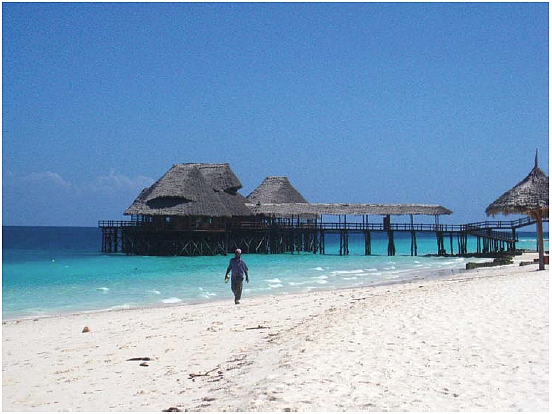
Zanzibar, Tanzania © Rashid Azzan
6. Appendices
The aim is to emphasise the important role of land governance in addressing
the MDGs but also articulating the input of land professionals and their
contribution that promotes engagement from all sectors of society. This will
require a strong and deep commitment to establishing a healthy land
professionals´ network.
Presentations are available at the on-line at the FIG web site for the
Congress in Sydney:
http://www.fig.net/pub/fig2010/techprog.htm#FIG_2010


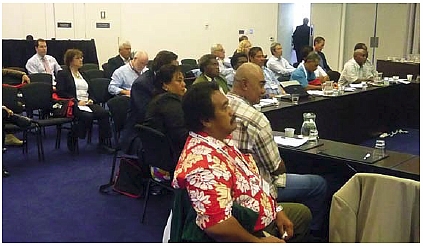
SIDS Seminar at FIG Congress, Sydney, Australia, 14th–15th April 2010.
© Stig Enemark
SESSION 1 – BUILDING PROFESSIONAL CAPACITY
Mele Rakai, President of PILPA, Fiji
There are a rage of problems to be faced by in the Pacific Region such as lack
of land professionals, lack or quality professional education and training of
land professionals, lack of engagement between governments and professional
associations, and lack of adequate resources for education and capacity
building. The Pacific Island Land Professionals Association (PILPA) was
established 2008 at the FAO/UPS Good Governance in Land Seminar held July 2008
in Suva, Fiji to address these problems and more, generally, to extend
understanding of the importance of professionals who can deliver land management
skills in support of the MDGs.
Antonio Wycliffe PNG
With a Pacific SIDS perspective highlighted the National Land Development
Taskforce report on capacity needs specifically that the basic professional
skills in the region are adequate but specialist skills and research and
development skills are lacking. To overcome the reliance on professional
foreign consultancies strong professional bodies need to be established and
the provision of continuing professional development forums.
Jackson Vaikota, Solomon Islands
The two broad professional challenges are technical and articulating customary
system. First, private practice provides technical survey and valuation skills
to relieve ministry work load; but policy capacity is lacking. Second a Land
reform group is seeking to transform the local customary system to mobilize land
for development; but this needs to be achieved in a cost effective system.
Overseas and Intra island exchange educational programs are needed, coupled with
in-service training and as necessary selective engagement of foreign experts
should be considered.
Faatasi Malaloga, Tuvalu
Public government departments are often poorly resourced on Pacific
Islands such as Tuvalu. The problems are compounded by limited training for
professional assistants. Survey regulations and land management standards do not
exist so survey standards are often being adopted ad-hoc. Building capacity
needs to include formalising professional accreditation from neighbouring
countries and providing local training programs.
David Neale, Trinidad and Tobago
Providing a snapshot of capacity building experiences from the Caribbean SIDS
region (24 States), and emphasising that many of the same capacity issues arise
such as politics, training, and convincing the public. A Caribbean ongoing
positive solution is the collaboration and cooperation of an active university
that operates across 11 countries. This has the benefit of pooling resources and
talent.
Marnie Laybourne, Australia
The Surveying and Spatial Science institute (SSSi) was formed 2009 as a
merger between the Institute of Surveyors Australia and Spatial Science
Institute. SSI is keen to explore ways to support SIDS through engagement as a
professional group, addressing training needs, and enhancing professional
opportunities and standards in the Pacific.
SESSION 2 – CLIMATE CHANGE AND NATURAL DISASTERS
Grenville Barnes, USA
The findings of research on land tenure issues following hurricane Ivan
in Grenada, and hurricane Mitch in Honduras, focused on pro-poor land governance
issues. Donor agency insistence that that all recipients of aid for new houses
hold a valid land title, does not account for the majority of the most
vulnerable people not holding title. Short and long-term actions were suggested
to improve resilience. Among the short-term measures were diversification of
livelihoods, improving tenure security along a “ladder of rights”, and
resettlement away from the most vulnerable areas.
Toelau Iulio, Samoa
Particular interest and action to land practitioners in the recovery
after the Samoa 2009 tsunami was the damage to the Samoa Survey Control Network.
The Department of Lands role was to organise resettlement of people away from
vulnerable coastal lands to higher land. This required relocation of
infrastructure such as water supply to the newly developed areas. Before this
could occur the geodetic network needed to be upgraded and extended into the new
areas to meet the demand of land development.
Eric Gorapava, Solomon Islands
The 2007 Earthquake in the Solomon Islands led to the resettlement of
large numbers of people from coastal lands to state land and customary lands.
The result is government eviction of people from state owned lands that
are earmarked for national projects. Indeed active involvement of rural
communities in recovery and reconstruction can be realized through a proper
village planning process. Long-term improvements to tenure security can be
achieved by demarcating relocation sites and granting fixed-term titles to the
displaced families.
Masang Bagingdo, PNG
PNG is particularly vulnerable to all types of natural disasters PNG
survey practitioners operate specifically in mapping and assessing climate
change affected areas (hot spots). The legislative structure has come under
pressure and subsequent review, but significant difficulties in surveying the
customary lands (approximately 97%) exist. Capacity building initiatives include
the development of postgraduate diploma, and a review of surveying legislation,
and education and training based on lessons from previous disasters.
SESSION 3 – ACCESS TO LAND & MARINE RESOURCES
Max Kepp, Papua New Guinea
PNG has the largest urban population in the Pacific Region with 900,000
people living in urban areas with a current growth rate of 13%. There several
examples of unsatisfactory land administration. PNG via its National Land
Program is leading the way in land reform in the Pacific region via a suite of
institutional, policy, and legislative changes, with a focus on urban areas.
Felitsita Heather Ikenasio, Samoa
The Samoan registry system is based on deeds and was moved onto the
Torrens system in 2009. Tenure categories are 81% customary land (81%), freehold
(4%), communal or public land (15%). A review of the alienation of customary
Lands Act 1965 is under way. There is currently a review of alienation of the
Customary Land Act and a 2008 act amendment enables the registration customary
lands through the customary courts.
Charlie Tereapii, Cook Islands
The country consists of 15 small islands, with a population of 19,500.
They use the NZ Survey Act and there is no land subdivision town planning
legislation. Absentee land ownership is high as 80% of Cook Islands live
overseas. There is an urgent need to fully brief politicians on land
administration weaknesses and the reforms needed.
Kulene Sokotia, Tuvalu
Tuvalu is an independent sovereign state of 9 tiny islands in a
sovereign state with a population of 11,000 people. Land ownership remains with
indigenous people, and land is seen as the not only mother but also a commodity
that is very precious and therefore requires careful management for the future.
Important to convince politicians to adapt and adopt regional and international
concepts of land management systems.
Azzan Rashid, Zanzibar
Zanzibar has a population of 1 million with 40million population in the
whole of Tanzania. Major land issues in Zanzibar and the wider region are
security of tenure for land holders of whom 80% live in rural areas and depend
on subsistence agriculture. Parcels of land are owned in community system. There
is a need for clear policies and legislation for land transfer, acquisition,
humanized and community involvement.
SESSION 4 – GOOD GOVERNANCE IN LAND TENURE AND ADMINISTRATION
Paul Munro-Faure, FAO
Development of the FAO Voluntary Guidelines is an ongoing process in the
context of the Pacific. A cross section of local partners, including private,
government and academia are invited to discuss topics over 2.5 days. It is
planned that sessions will be held in the Caribbean in September 2010 and the
Pacific Sub-office are to meet again in July 2010. The voluntary guidelines are
an intensive and challenging process that is hoped to be of benefit to the
people that are invited and countries that will adopt the guidelines.
Pepi Kimas, Papua New Guinea
Land being a central role in the everyday lives of Papua New Guineans is
seeing a change. Major developments are occurring now to ensure that customary
land holders have the opportunity to benefit from potential development returns
from their land. To date, most economic activities were conducted on state land.
The government have set a 2050 Vision for easier access to customary land.
Ruth Liloqula, Solomon Islands
There is a need to re-establish professionalism in the land sector to
eliminate corruption as key strategies in building community trust. There is
ethnic tension caused by customary and crown lands. Good governance in land
affects national well being and too many land disputes occur in Solomon Islands.
Capacity building must build independence rather than dependence through
mentoring.
Maraia Ubitau, Fiji
The large majority of Fijian land is under native tenure (88%), half of
this which is under Native Reserve, while the remained is held under freehold
(8%) and State land (4%). Numerous legislative acts help to provide a strong
legal framework for the management of land covering all legal tenures. There are
many strengths within the current Fiji land administration system, however there
are also some weaknesses, including the problem of ensuring that the development
decisions of the Native Land Trust Board provide optimal returns to customary
land holders.
Romano Reo, Kiribati
The Kiribati Islands home to 95,000 people with almost half of the
population living in the Capital on the main island of Gilbert. Only 37% of land
is under customary land tenure on the main Gilbert Island while the remainder is
all State owned. Squatters operate on government lease land due to urban drift
and population growth. Landowners pressure government for surrender of
undeveloped portion of leased lands.
Pele Fuata’I, Samoa
The geodetic control and survey network has been upgraded, and there has
been digitisation
of data to the Torrens system in a recent upgrading land administration and
cadastre project. This eliminated the Deeds system. However natural disasters
have since broken the server and the backup and a new solution is required to
retrieve the data. Effective capacity building is mostly through hands on
training, on-the-job training and study tours. Ongoing communication via email
and internet are useful for support after assistance has finished.
Fetu’u Vea, Tonga
The strengths in land governance are historical. All principles of MDGs
were in Tongan Constitution of 4 Nov 1875 and related land acts with rights to
any male of 16 and over land, access and development. Current governance
weaknesses include: Shortage of land professionals, including cartographers;
Some of the work is still done manually, however the World Bank have
computerised the registry; Financial constraints prevent further reform.
SESSION 5 – BUILDING PROFESSIONAL CAPACITY
Chris Lunney, Australia
Developing countries need to be in a position to ensure that their land
is: effectively and appropriately managed; can support the economic growth of
the country; and that people’s interests in their land is provided with an
acceptable level of protection. This requires governments to have in place
effectively operating land administration systems. Through a few case studies it
is possible to gain an appreciation of where capacity building has failed or
conversely been successful. This relates to studies of capacity building
activities in Lao PDR (Asia), Lesotho (Africa) and the Pacific Nations.
Michael Mangawai, Vanuatu
SIDS professionals need to overcome the situation whereby they have to
use other nations tools. Typified by the UNDP land administration projects which
uses a Needs Assessment Tool; SIDS should be developing their on specialised
land tool, and resist agencies treatment of land administration as a
cross-cutting issue, merged into other sectors such as water, forests,
environment, agriculture, cities, etc. The important issue for SIDS is their
professional relationships with funding agencies and access to funding streams.
Ueligitone Seiuli, Samoa
Graduates are needed to meet capacity needs. Field practice is essential
for professional recognition. Funds must be available for training and new
equipment and travel.
Sevanaia Dakaica, Fiji
There are large numbers of land practitioners across the Pacific Island
countries who are not formally trained and qualified. There are constraints to
self funding studies and existing scholarships does not prioritise land
management studies. Only PNG and Fiji have tertiary education institutions for
land practitioners. Literature calls for multiple strategies for capacity
building in the land sector; relying on new partnerships and use of distance and
flexible learning. Land reform public discussion organised in Fiji was well
attended by Fijians.
Marnie Laybourne, Australia
Reinforced what was said yesterday about strong partnerships with SSSI
to address capacity needs. Members of SSSI are keen to help develop capacity in
home countries.
Loia Tausi, Tuvalu
Climate change will impede nation´s ability to achieve sustainable
development pathways as to achieve our MDGs. Important to map vulnerabilities in
precise terms as land professionals and learn how to implement good governance
and to deal with corruption. Share lessons learned by neighbouring countries to
enhance capacity. Ending women’s disadvantage is important. Adaptation is the
way forward to achieve resilience. Monitoring and evaluating capacity needs is
essential. Financial assistance is greatly needed by SIDS.
Martin Sokomanu, Vanuatu
Scale of challenges combine geography, plate tectonic activity, poor
agricultural soils, and 90% land in customary land tenure (and practices) for
use of family members. Land administration department is guided by the Planning
Long Acting Short Matrix 2010–2015 (PLAS Matrix) that steers government priority
action agenda framework. But a major challenge is the lack of land professionals
and clear defined land policies. There is a need to amend the MDG Needs
Assessment Tool (UNDP) which does not suit the Vanuatu context.
Richard Siataga, Niue
Niue is a small raised coral island of 259 sq km with a population of
1,625 (2006) and governed by the Assembly of 20 elected members. The gap between
domestic production and demand for goods and services is very wide and makes
Niue heavily dependent on foreign aid. Challenges relate to lack of qualified
staff (brain drain), lack of modern equipment, and lack of training and
upgrading opportunities. Empirical lessons resulting from cyclone Heta (2004)
where land data was destroyed, leading to increased need for overseas technical
assistance.

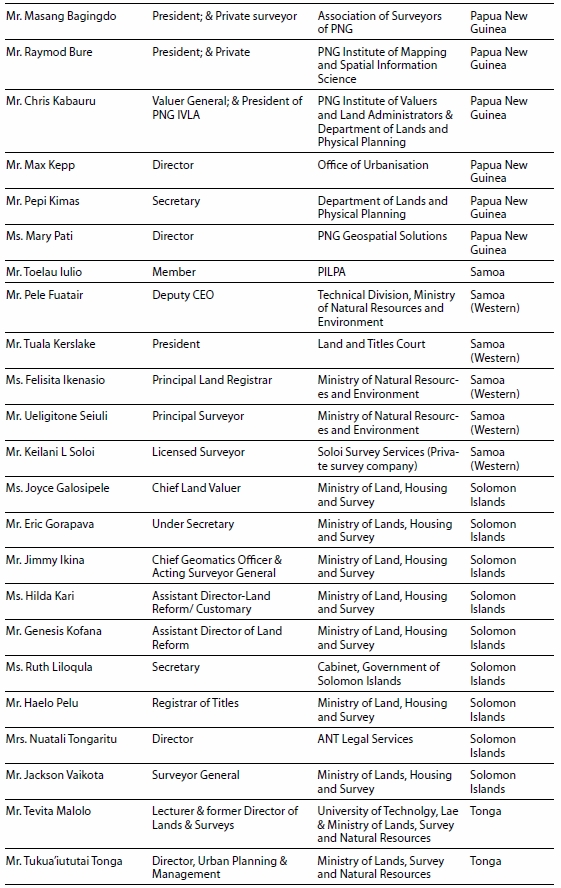
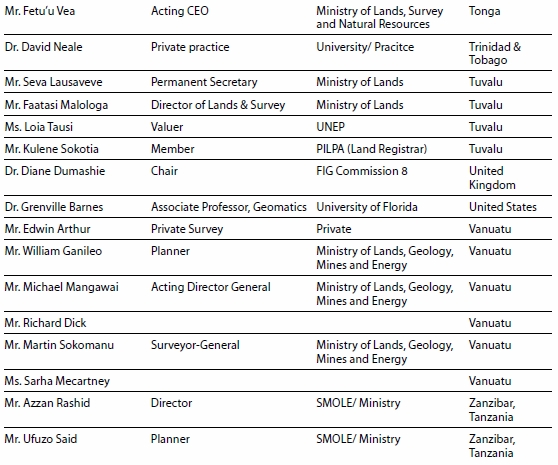
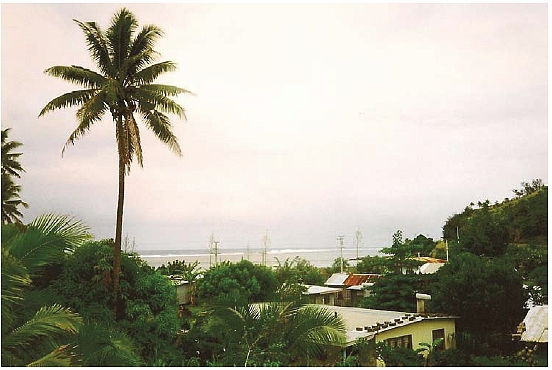
Fiji. © Stig Enemark
Stig Enemark and Matt Higgins: The Global Development Agenda, Its Relevance
to the Asia Pacific Region and the Role of the International Federation of
Surveyors (FIG). Combined 5th Trans Tasman Survey Conference & 2nd Queensland
Spatial Industry Conference 2006 – Cairns, 18–23 September 2006.
Good Governance in Land Seminar. FAO and ISP, Suva, Fiji, July 2008.
http://www.usp.ac.fj/index.php?id=6806
Barbados Programme of Action for the Sustainable Development of Small Island
Developing States. Bridgetown, Barbados, 25 April – 6 May 1994.
http://www.un.org/esa/dsd/dsd_aofw_sids/sids_pdfs/BPOA.pdf
Small Islands Big Stakes, UN International Conference, Port Louis, Mauritius,
10–14 January 2005.
http://www.un.org/smallislands2005/
Mauritius strategy; UN International conference, Port Louis, Mauritius, 14
January 2005.
http://www.undppc.org.fj/_resources/article/files/Mauritius_Strategy_Inserts.pdf
UNEP Islands web site.
http://islands.unep.ch/dsidspoa.htm
UN Millennium Development Goals.
http://www.undp.org/mdg/index.shtml
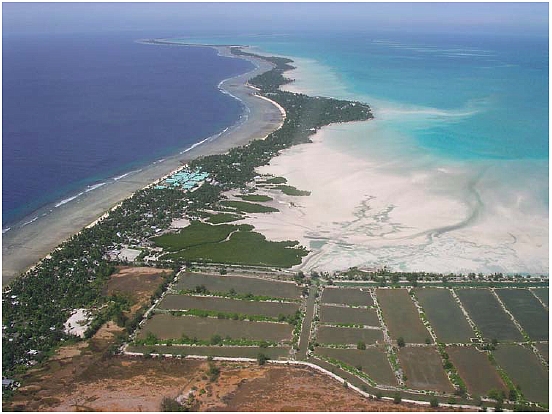
Low lying atoll, Kiribati © Romano Reo
Copyright © International Federation of Surveyors, November
2010
All rights reserved
International Federation of Surveyors (FIG)
Kalvebod Brygge 31–33
DK-1780 Copenhagen V
DENMARK
Tel. + 45 38 86 10 81
E-mail: FIG@FIG.net
www.fig.net
Published in English
Copenhagen, Denmark
ISBN 978-87-90907-84-6
Published by
International Federation of Surveyors (FIG)
Front cover: left: St .Lucia © Stig Enemark; right: Maui, Hawaii, USA © Stig
Enemark
Back cover: Kiribati © Romano Reo
Editors: Dr. Diane Dumashie and Prof. Stig Enemark
Design: International Federation of Surveyors, FIG
|
























